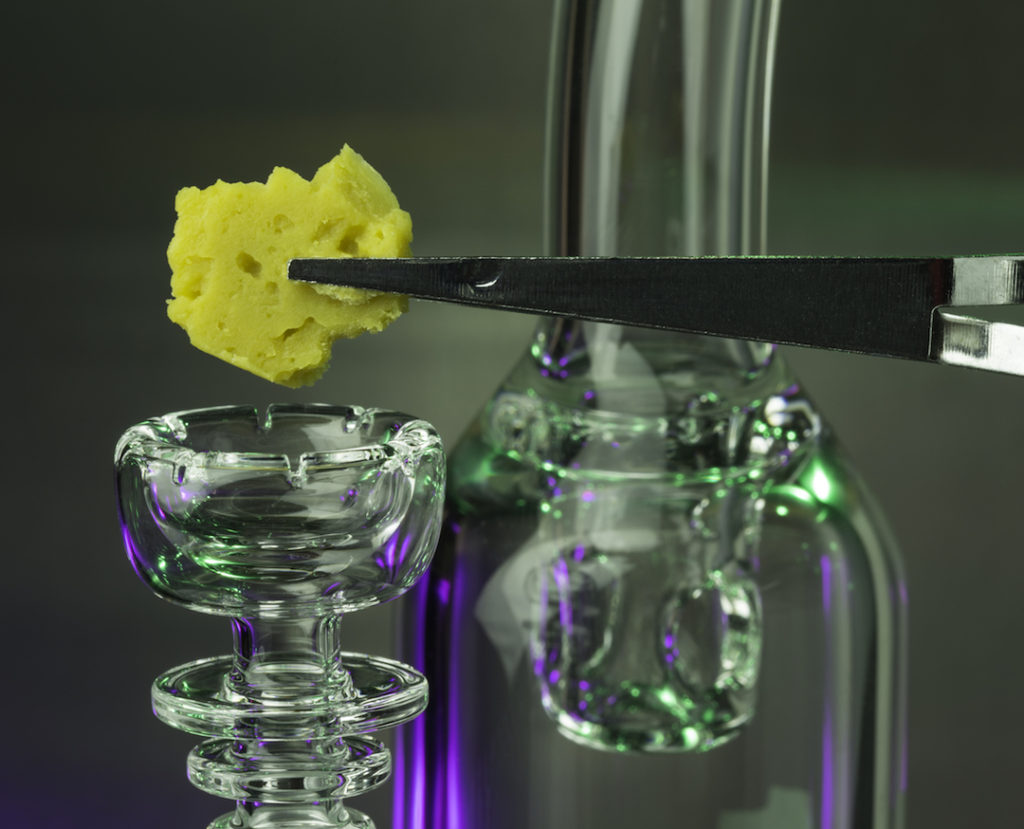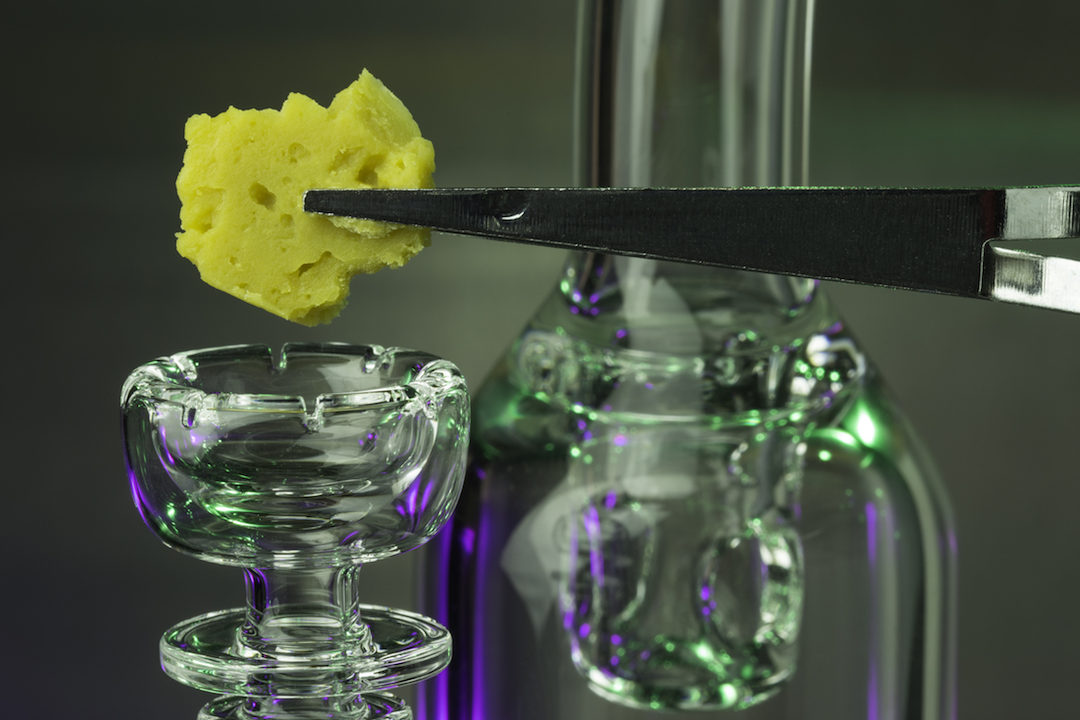Cannabis Extracts, Concentrates and Hash Explained

There’s been a revolution in the types of concentrated cannabis products available on the market these days, with a plethora of options including traditional hash and kief, plus extracts such as shatter, wax, sugar and live resin made using cutting-edge techniques.
It can be confusing to understand the differences between various types of extracts, as well as how to safely consume them, especially if you are new to cannabis. We’ll work to demystify these potent products for you, introducing a whole new world of cannabis connoisseurship.
Why Use Extracts?
The idea behind all of these products is the same—strip the potent resin away from the plant matter, since the resin contains the psychoactive THC in the highest amounts, along with other desirable cannabinoids, terpenes and flavinoids. Concentrating these cannabinoids into a shiny, translucent glob of resin that resembles sap, amber or raw honey allows dabbers to receive more potent effects while avoiding inhaling any harsh plant matter.
Resin is found in the trichomes of the cannabis plant, which look like sparkling crystals to the naked eye. When your buds look shiny and frosty, that means there’s a large amount of resin present, indicating a high-quality product. Harvesting these resinous trichomes is possible through a variety of techniques including dry sifting, ice water extraction or hydrocarbon extraction.
In general, concentrating the cannabinoids means that the user needs much less to receive the same effects, making extracts a good choice for those concerned about damage to the lungs. For medical users, the instant relief provided by inhaling just one tiny dab can rival smoking an entire joint. Intense and powerful, traditional hash can measure around 50% THC while extracts can reach 70 – 90% THC.
What Are These Products?
Kief: Resembling brown sugar or cinnamon, kief is truly the spice of life. The most basic type of traditional hash, kief is created by “dry sifting,” tumbling cannabis flowers or trim in a drum-shaped device known as a “Pollenator” which separates the resin away from the plant matter as it rotates. These loose resin crystals can be sprinkled into a joint, eaten, vaporized or smoked as is. Kief still contains a significant portion of plant material, making it less high-quality than a hash that’s composed of mostly trichomes.
Cold Water Hash: Extracted using a manual method involving agitating plant matter with ice in a container such as a five gallon bucket or automatically in a device that resembles a washing machine. The trichome heads on the plant contain the cannabinoids and terpenes, and combining the plant matter with the cold water mixture causes these trichomes to become brittle and break off. After agitating for about 30 minutes, the watery solution filtered through a series of fine mesh bags, collecting the trichomes in varying grades from coarse to fine quality. After being dried and cured, hash makers microplane their hash patties to increase the surface area, allowing even drying which improves the color and taste. The result is a product that resembles sand or brown sugar, which can be added to joints, crumbled on top of bowls or smoked as is.
Wax: Looking like a thick, creamy paste, wax is created using a solvent to extract the cannabinoids and terpenes from the plant matter. The solvent is then purged and what remains is a concentrated mass of cannabinoids. The presence of THCA and other non-decarboxylated solids separating from the oils can make the concentrate opaque. The process of extracting a wax and shatter are very similar; it is through agitating the concentrate via mixing or whipping that creates a waxy, opaque, crumbly structure.
HTFSE: An abbreviation for High Terpene Full Spectrum Extract, this cannabis extract is rich in flavorful terpenes as well as a full spectrum of cannabinoids. Originally processed in the same way as wax, HTFSE is then allowed to sit and slowly purge naturally, rather than being quickly purged of solvent in a vacuum oven. Over time, the terpenes separate from the THC crystals, leaving a thick layer of so-called “crystals” or “diamonds” surrounded by a low-viscosity layer of delicious “terp sauce” on top.
Live Resin: Looking like sap or amber, live resin is a whole plant extraction where ripe flowers are frozen immediately after harvest, ensuring that terpenes are preserved. The concentrate is extracted in a sub-zero temperature to manage the amount of moisture in the extracts. The flowers have not been dried or cured so the terpenes have yet to evaporate leaving an exponentially more flavorful concentrate. Live resin is perishable and should be consumed as soon as possible for maximum flavor.
Rosin: This product can be created by processing trim, flower, kief, or hash using heat and pressure. Compressed between a set of lightly-heated plates with thousands of pounds of pressure, the cannabis material oozes resin, while the trichomes within kief and hash glom together in a uniform mass. After being pressed, the rosin is placed in parchment and sandwiched between two ice-cold metal slabs for less than five seconds to stop the heating process. The result is an extract with the fresh flavors of various cannabis strains that’s suitable for dabbing. Rosin is best consumed within a few days of being made, or it can be stored in a cool, dark place.
Shatter: Reminiscent of amber, shatter is translucent and can vary in color from a pale gold to a deep honey. Using a hydrocarbon solvent to strip and extract cannabinoids and beneficial oils like terpenes from cannabis results in shatter. The only difference between wax and shatter is ensuring that the process of extracting and purging is completely uniform and consistent with no mixing or variables changing during the process. For a completely stable shatter the starting materials must be rich in THCA and not decarboxylated because the presence of more THC can make the concentrate sappy.
Sugar: This product is the result of leaving shatter to cure, with the naturally occurring terpenes breaking down the shatter and transforming it into an extract with more texture that resembles sugar. Called “nucleation,” this transformation happens naturally when lipids in the extract no longer want to remain fully emulsified in a homogenized, stable state. Connoisseurs have found that this sugar can be more flavorful than shatter, leading to more demand for these types of products.
Should You Be Concerned About Solvents?
Some extracts are made using ice water, while other are made with Co2 or hydrocarbon solvents including butane, propane or hexane. Extracts and hashes are tested by analytical laboratories to ensure that all of the solvent has been purged out of the product, while water hashes are confirmed to be free of any mold.
Always ask your cannabis consultant about the specific solvent used to make your concentrates, as post-extraction techniques can result in similar textures for items processed with butane or Co2. Cannabis oils used in vape pen cartridges are also made in a similar way.
How to Store Extracts
When handling these sticky extracts, it’s important to use the right tools to make sure these precious substances are used most efficiently. Concentrates arrive in small jars or parchment envelopes, and it’s necessary to have a set of small tools to handle and consume these items. Known as “dab tools,” a set of pokers, scoops, and angled scrapers will help you get a small amount of extracts from jar to consumption device.
Keep concentrates in a cool dry place, and store in a wine fridge for longer periods. Use live resin as soon as possible, since these types of extracts are highly perishable.
How to Consume Extracts
Most dabbers use a quartz or titanium nail attached to a water-filtering pipe similar to a bong. Known as a “dab rig,” these devices can be simple and straightforward, or an elaborate work of art. The quartz or titanium nail is usually heated using a blowtorch, then allowed to cool to a suitable temperature before dropping the extract on the nail, covering with a carb cap, and inhaling through the rig.
For those who don’t want to use a blowtorch, options include so-called e-nails, which can be heated electronically to a precise temperature.
Certain models of vaporizers can also be used for concentrates, making the process safer and more discreet. The Firefly 2 and Pax 3 models are recommended for this use.
The Future of Cannabis
While concentrates, hashes and extracts currently make a up a small segment of the market for cannabis products, all available evidence suggests that interest in these items will continue to grow as more people learn how to appreciate these flavorful, enjoyable resins, waxes and oils. Convenient vaporizers and vape pens make savoring these hashes easier than ever before, and the instantaneous high converts many former flower smokers into dabbers after experiencing the effects and flavors.
Come on down to KindPeoples, check out our wide variety of extracts and try it for yourself!

